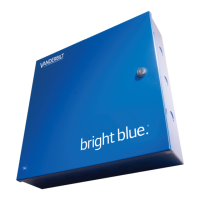Example: A PIM400 is being added to the system, and it will have 8 AD-400 locks communicating with it. These
are the only devices on this channel, so there are no other device addresses to worry about. The PIM400 will be
set at address 0, with a Low value of 0 and a High Value of 7 (meaning the AD-400 locks will be addressed from 0
to 7). In the bright blue interface, the PIM400 will be addressed as 0 and the AD-400 locks will be addressed as
0 through 7.
When adding multiple PIM400s to the same channel, the second PIM should have the next available address and
its LOW/HIGH range for the AD-400 locks communicating with it should start at that number.
Example: A second PIM400 is being added to the system, on the same channel as the first above. There will be
6 AD-400 Locks communicating with this PIM400. The addresses of the original PIM400 and AD-400 locks has
already been set (see above example) so the new PIM400 will have to take this into account. The PIM400 address
will be set to 8 (the next available number) and the Low value will be set to 8 and the high value will be set to 13.
In bright blue, this PIM400 will be addressed at 8 and the AD-400 locks communicating with it will be addressed
from 8 through 13.
When adding wired locks to the same channel as a PIM400, you have to take into account the difference in
addressing.
Example: An VBB-RI is being added to the system, as the same channel as the PIM400s above. The address of
the two PIM400s and their locks has already been set (see the above examples) so the VBB-RI will have to take
this into account. The first PIM400 and its locks are taking up addresses 0 through 7 and the second PIM400 and
its locks are taking addresses 8 through 13, so addresses 0 through 13 are taken. This counts as addresses 1
through 14 (0+1=1 and 13+1=14) for the hardwired locks. So the VBB-RI will be put on the next available address,
which is address 15.

